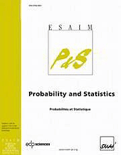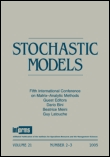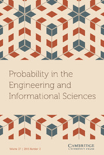
ESAIM-Probability and Statistics
Scope & Guideline
Exploring the frontiers of statistical knowledge.
Introduction
Aims and Scopes
- Probability Theory:
The journal publishes articles that explore fundamental aspects of probability, including stochastic processes, random walks, and diffusion processes. This area emphasizes the mathematical underpinnings of randomness and uncertainty. - Statistical Methods and Applications:
It covers a wide range of statistical methodologies, including hypothesis testing, Bayesian statistics, and multivariate analysis, often applied to real-world problems in various fields such as biology, finance, and engineering. - Stochastic Modeling:
The journal features research on stochastic models that describe complex systems, including Markov processes, Lévy processes, and their applications in various domains such as ecology and epidemiology. - Asymptotic Analysis and Convergence:
A significant focus is placed on asymptotic properties of estimators and statistical tests, providing insights into the behavior of statistical procedures in large samples. - Interdisciplinary Applications:
The journal encourages contributions that apply probabilistic and statistical theories to interdisciplinary fields, highlighting the relevance of these methods in solving practical problems.
Trending and Emerging
- Machine Learning and Data Science:
There is a clear trend towards integrating statistical methodologies with machine learning techniques, as evidenced by papers exploring Bayesian learning, kernel methods, and statistical learning theory, reflecting the growing importance of data-driven approaches in modern research. - Stochastic Processes in Complex Systems:
Research on stochastic processes, particularly in the context of complex systems such as ecological models and financial markets, is gaining prominence, highlighting the need for advanced probabilistic tools to model intricate interactions. - Non-Asymptotic Analysis:
An increasing focus on non-asymptotic methods indicates a shift towards understanding the performance of statistical procedures in finite samples, rather than solely in asymptotic terms, catering to practical applications. - Applications in Epidemiology and Ecology:
With rising global health concerns and environmental issues, research applying probabilistic models to epidemiology and ecological systems is emerging, demonstrating the journal's adaptation to societal needs. - Advanced Stochastic Calculus and Differential Equations:
Emerging themes in advanced stochastic calculus and its applications to differential equations reflect a growing interest in understanding dynamic systems through probabilistic frameworks.
Declining or Waning
- Classical Statistical Inference:
Traditional topics such as classical maximum likelihood estimation and frequentist hypothesis testing seem to be less frequently addressed in recent publications, possibly overshadowed by more modern Bayesian approaches and machine learning techniques. - Deterministic Models:
Research centered around deterministic models, which were previously more common, appears to be diminishing as the field increasingly embraces stochastic and probabilistic frameworks that better capture real-world uncertainties. - Basic Limit Theorems:
While foundational limit theorems remain essential, there is a noticeable decline in publications focusing solely on these topics, as researchers are now integrating them into broader, more complex stochastic models.
Similar Journals

JIRSS-Journal of the Iranian Statistical Society
Elevating Research Standards in Statistics and Probability.JIRSS - Journal of the Iranian Statistical Society is a prominent academic journal dedicated to the field of statistics and probability, published by the esteemed Iranian Statistical Society. With its ISSN number 1726-4057 and E-ISSN 2538-189X, this journal serves as a vital platform for disseminating cutting-edge research and advancements in statistical methodology and its applications. Established in 2011, JIRSS has consistently contributed to the academic community, achieving a 2023 Scopus rank of #180 out of 278 in its category, placing it within the 35th percentile in the dynamic domain of Mathematics: Statistics and Probability. As an Open Access publication, it enhances accessibility for researchers, professionals, and students, facilitating a wider engagement with innovative statistical techniques and theories. The journal aims to foster collaboration and knowledge exchange among statisticians, ultimately enriching the field and its impact on various scientific disciplines.

ALEA-Latin American Journal of Probability and Mathematical Statistics
Uniting theory and application in probabilistic modeling.ALEA - Latin American Journal of Probability and Mathematical Statistics is a pivotal publication in the field of statistical theory and probabilistic modeling, published by the renowned Instituto de Matemática Pura e Aplicada (IMPA) in Brazil. Since its inception in 2011, this journal has steadily established itself as a key resource for researchers and academics, currently ranked in the Q2 category for Statistics and Probability as of 2023. With an H-index reflecting the sustained influence of its published research, ALEA serves not only as a platform for innovative studies but also as a vital conduit for the dissemination of cutting-edge statistical methodologies across the Latin American region and beyond. The journal is committed to maintaining high scholarly standards, encouraging open discussions on theoretical and applied aspects of probability and statistics. Access options include subscription-based access, ensuring a wide reach for its scholarly content. Whether you are a seasoned professional or a student embarking on your research journey, ALEA offers invaluable insights that contribute to the advancement of knowledge in the ever-evolving realm of mathematical statistics.

ELECTRONIC COMMUNICATIONS IN PROBABILITY
Empowering Researchers with Open Access to ProbabilityELECTRONIC COMMUNICATIONS IN PROBABILITY is a distinguished open-access journal published by the Institute of Mathematical Statistics (IMS) that has been contributing to the field of statistics and probability since its inception in 1996. With a commitment to disseminating high-quality research, this journal plays a crucial role in fostering advancements in the areas of statistical theory and probabilistic models. The journal's impact is reflected in its notable rankings, including a Q2 categorization in both Statistics and Probability and Statistics, Probability and Uncertainty for 2023, indicating its relevance and scholarly influence in the academic community. Having a consistent converged publication timeline from 1996 to 2024, it provides researchers, professionals, and students with a platform to share and access innovative studies without barriers. With an aim to enhance our understanding of statistical applications and methodologies, ELECTRONIC COMMUNICATIONS IN PROBABILITY serves as an essential resource for those engaged in statistical research and applications.

METHODOLOGY AND COMPUTING IN APPLIED PROBABILITY
Exploring the synergy between probability and computational techniques.METHODOLOGY AND COMPUTING IN APPLIED PROBABILITY is a distinguished journal published by SPRINGER, dedicated to advancing research in applied probability and its relationship with various computational methodologies. With an ISSN of 1387-5841 and an E-ISSN of 1573-7713, this journal provides a platform for innovative studies that bridge theory and practical application in the field of mathematics and statistics. Ranking in the Q2 category for Mathematics (miscellaneous) and Q3 for Statistics and Probability as of 2023, it reflects a robust academic discourse, featuring contributions that span a range of methodologies utilized in probability-related studies. The journal's sustained engagement in the academic landscape from 2004 to 2024 puts it at the forefront of ongoing developments in statistics and probability. Researchers, professionals, and students alike will find the insights found within to be invaluable for both theoretical understanding and practical implementation.

STOCHASTIC MODELS
Pioneering insights into applied mathematics and its applications.STOCHASTIC MODELS, published by Taylor & Francis Inc, is a reputable journal dedicated to the field of applied mathematics, particularly focusing on the realms of modeling and simulation, as well as statistics and probability. With an ISSN of 1532-6349 and an E-ISSN of 1532-4214, the journal has made a notable impact since its inception in 2002 and is recognized for contributing valuable research until 2024. A Q3 ranking in 2023 within the categories of Applied Mathematics and Modeling & Simulation, alongside a Q4 ranking in Statistics and Probability, underscores its significant role in advancing scholarship in these areas, despite the competitive landscape. While not an Open Access journal, it offers an array of access options to cater to its diverse readership comprised of researchers, professionals, and students. Situated in the United States, STOCHASTIC MODELS serves as a critical platform for disseminating innovative ideas, methodologies, and applications that drive forward the understanding of complex stochastic phenomena.

PROBABILITY IN THE ENGINEERING AND INFORMATIONAL SCIENCES
Bridging theory and application through innovative probabilistic research.PROBABILITY IN THE ENGINEERING AND INFORMATIONAL SCIENCES is a premier journal published by Cambridge University Press, dedicated to advancing the fields of statistics, probability, and their applications within engineering and informational sciences. With an ISSN of 0269-9648 and an E-ISSN of 1469-8951, this journal has established itself as a significant resource since its inception in 1987, continuing to publish impactful research through 2024. Ranking in the Q2 category for Industrial and Manufacturing Engineering and holding Q3 status in multiple relevant categories, it boasts a respectable impact in academia, reflected in its Scopus rankings across various disciplines. Although not an open-access journal, it remains essential for researchers interested in the integration of probabilistic methods in contemporary engineering challenges. By providing a platform for innovative studies and practical applications, PROBABILITY IN THE ENGINEERING AND INFORMATIONAL SCIENCES plays a crucial role in shaping future research and methodologies in these overlapping domains, fostering collaboration and knowledge exchange among researchers, professionals, and students alike.

STATISTICAL SCIENCE
Empowering Research Through Rigorous Statistical Insights.STATISTICAL SCIENCE, published by the Institute of Mathematical Statistics (IMS), stands as a premier journal in the fields of Statistics and Probability, commencing its journey in 1986 and continuing through 2024. With an impressive track record reflected in its Q1 quartile rankings in Mathematics, Statistics and Probability, and Statistics, Probability and Uncertainty for 2023, it holds a distinguished position in the academic community. The journal is recognized for its rigorous peer-review process and for publishing high-quality research that significantly contributes to advancing statistical methodology and its applications across various domains. Researchers and professionals are encouraged to engage with its contents to stay abreast of the latest developments and methodologies in statistical science. Although it does not offer open access, the valuable insights provided within its pages are essential for any scholar dedicated to the pursue of statistical excellence. As you navigate the complexities of data analysis and interpretation, STATISTICAL SCIENCE is your go-to resource for groundbreaking research, innovative techniques, and comprehensive reviews.

THEORY OF PROBABILITY AND ITS APPLICATIONS
Empowering Research in Statistical ApplicationsTHEORY OF PROBABILITY AND ITS APPLICATIONS, published by SIAM Publications, is a crucial journal dedicated to advancing the field of probability and its extensive applications. With its ISSN 0040-585X and E-ISSN 1095-7219, this esteemed publication has been a vital resource for scholars and practitioners since its inception. Operating out of the United States, the journal has a commitment to supporting research that falls within the Q3 quartile in both Statistics and Probability, as well as in Statistics, Probability, and Uncertainty for 2023. Despite its current position in a competitive landscape, ranked #137 in Statistics, Probability and Uncertainty and #227 in Mathematics, this journal remains an essential platform for disseminating innovative ideas and breakthroughs in probability theory. Although it lacks an open-access model, its rigorous peer-reviewed articles offer invaluable insights to enhance both theoretical understanding and practical application. With a focus on fostering collaboration and inspiring future research, THEORY OF PROBABILITY AND ITS APPLICATIONS is indispensable for researchers, professionals, and students striving to delve deeper into the intricate world of probability.

Journal of the Indian Society for Probability and Statistics
Advancing the Frontiers of Statistical KnowledgeJournal of the Indian Society for Probability and Statistics, published by SpringerNature in Germany, is a prominent platform dedicated to advancing the field of statistics and probability. With its E-ISSN of 2364-9569, the journal features rigorous research articles, reviews, and theoretical advancements aimed at promoting the application of statistical methodologies in diverse areas. As part of the academic community since 2016, it has maintained a commendable Q3 ranking in the Statistics and Probability category for 2023, indicating its growing influence and relevance. As the journal aims to foster collaborations among statisticians and probabilists, it serves as an invaluable resource for researchers, professionals, and students looking to deepen their understanding and share innovative ideas. While the journal operates under a subscription model, its commitment to open access publication contributes to the broader dissemination of knowledge in this vital field, further enhancing its importance and utility within the scientific landscape.

Journal of Probability and Statistics
Championing Open Access for Statistical DiscoveryJournal of Probability and Statistics, published by HINDAWI LTD, is a distinguished open-access journal that has been serving the academic community since 2009. With an ISSN of 1687-952X and E-ISSN 1687-9538, this journal facilitates the dissemination of research covering various foundational and applied aspects of probability and statistics. As researchers, professionals, and students in the fields of mathematics and statistical sciences seek to advance their knowledge and understanding, this journal offers a unique platform for innovative studies and comprehensive reviews. Although the journal has been discontinued from Scopus from 2009 to 2020, it continues to play an essential role within its niche, despite its Scopus ranking of #181/227 (20th percentile) in Statistics and Probability. The open-access model ensures that valuable findings are readily accessible to a global audience, fostering collaboration and engagement across diverse disciplines. Join the multitude of contributors and readers who rely on the Journal of Probability and Statistics as a vital resource for research and education in this ever-evolving field.